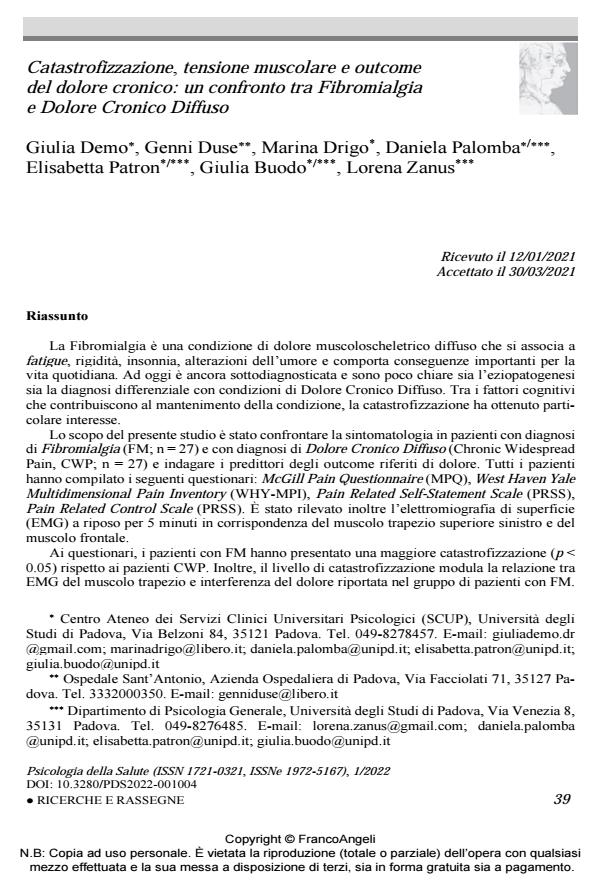Catastrofizzazione, tensione muscolare e outcome del dolore cronico: un confronto tra Fibromialgia e Dolore Cronico Diffuso
Titolo Rivista PSICOLOGIA DELLA SALUTE
Autori/Curatori Giulia Demo, Genni Duse, Marina Drigo, Daniela Palomba, Elisabetta Patron, Giulia Buodo, Lorena Zanus
Anno di pubblicazione 2022 Fascicolo 2022/1
Lingua Italiano Numero pagine 22 P. 39-60 Dimensione file 329 KB
DOI 10.3280/PDS2022-001004
Il DOI è il codice a barre della proprietà intellettuale: per saperne di più
clicca qui
Qui sotto puoi vedere in anteprima la prima pagina di questo articolo.
Se questo articolo ti interessa, lo puoi acquistare (e scaricare in formato pdf) seguendo le facili indicazioni per acquistare il download credit. Acquista Download Credits per scaricare questo Articolo in formato PDF

FrancoAngeli è membro della Publishers International Linking Association, Inc (PILA)associazione indipendente e non profit per facilitare (attraverso i servizi tecnologici implementati da CrossRef.org) l’accesso degli studiosi ai contenuti digitali nelle pubblicazioni professionali e scientifiche
La Fibromialgia è una condizione di dolore muscoloscheletrico diffuso che si associa a fa-tigue, rigidità, insonnia, alterazioni dell’umore e comporta conseguenze importanti per la vita quotidiana. Ad oggi è ancora sottodiagnosticata e sono poco chiare sia l’eziopatogenesi sia la diagnosi differenziale con condizioni di Dolore Cronico Diffuso. Tra i fattori cognitivi che contribuiscono al mantenimento della condizione, la catastrofizzazione ha ottenuto particolare interesse. Lo scopo del presente studio è stato confrontare la sintomatologia in pazienti con diagnosi di Fibromialgia (FM; n = 27) e con diagnosi di Dolore Cronico Diffuso (Chronic Widespread Pain, CWP; n = 27) e indagare i predittori degli outcome riferiti di dolore. Tutti i pazienti han-no compilato i seguenti questionari: McGill Pain Questionnaire (MPQ), West Haven Yale Multidimensional Pain Inventory (WHY-MPI), Pain Related Self-Statement Scale (PRSS), Pain Related Control Scale (PRSS). È stato rilevato inoltre l’elettromiografia di superficie (EMG) a riposo per 5 minuti in corrispondenza del muscolo trapezio superiore sinistro e del muscolo frontale. Ai questionari, i pazienti con FM hanno presentato una maggiore catastrofizzazione (p < 0.05) rispetto ai pazienti CWP. Inoltre, il livello di catastrofizzazione modula la relazione tra EMG del muscolo trapezio e interferenza del dolore riportata nel gruppo di pazienti con FM. I risultati suggeriscono che alti livelli di catastrofizzazione accentuino l’effetto negativo di elevati livelli di tensione muscolare in pazienti con FM.
Parole chiave:Fibromialgia, Dolore Cronico Diffuso, dolore cronico, catastrofizzazione, ten-sione muscolare.
Giulia Demo, Genni Duse, Marina Drigo, Daniela Palomba, Elisabetta Patron, Giulia Buodo, Lorena Zanus, Catastrofizzazione, tensione muscolare e outcome del dolore cronico: un confronto tra Fibromialgia e Dolore Cronico Diffuso in "PSICOLOGIA DELLA SALUTE" 1/2022, pp 39-60, DOI: 10.3280/PDS2022-001004